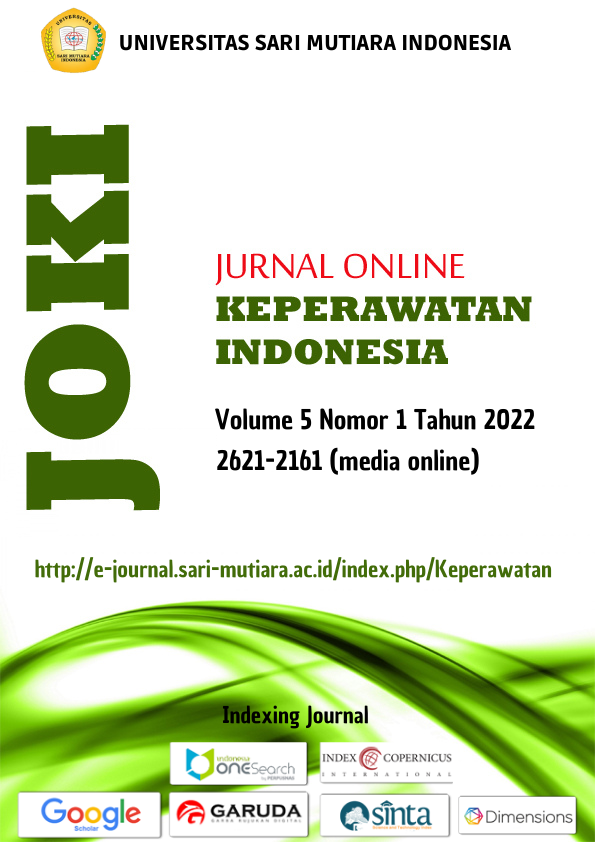GAMBARAN DETERMINAN PERILAKU POLA MAKAN KEJADIAN STROKE DIPUSKESMAS DALU SEPULUH TANJUNG MORAWA
DOI:
https://doi.org/10.51544/keperawatan.v5i1.2941Keywords:
Dietary Behavior of Stroke IncidenceAbstract
Stroke is a symptom that occurs due to impaired blood circulation in the brain.Objective: To find out an overview of the determinants of dietary behavior with stroke events in the dalu ten tanjung morawa health center in 2022.Research Method: using FFQ (Food Frequency Questionnaire). The results showed that 60 respondents at the Dalu Ten Health Center, Tanjung Morawa, with dietary behavior in the type of staple food was sufficient (61.7), the type of meat that had good fat, lacked (55.0), fish and less processing (50.0, enough vegetables and fruit (75.0%), only enough food (55.0%), sufficient food processing (58.3), sufficient and insufficient cooking spices (45.0%), less soft drinks (55.0 ), less dairy products (68.3%). Based on the dietary behavior of stroke patients in consuming staple foods, vegetables and fruit, only food, the food processing of stroke patients is sufficient to understand dietary behavior. Meanwhile, in consuming fatty meats, fish and their processing, cooking spices, and soft drinks, stroke sufferers are still lacking so that the eating behavior of stroke patients must increase food consumption patterns and the need to meet food consumption so that information on eating behavior of stroke sufferers is accurate and correct. Stroke sufferers must regulate their diet and avoid foods that contain high fat and cholesterol, besides that stroke patients are also advised to do physical activity, reduce stress levels by doing activities outside the home, taking vacations, exercising and quitting smoking to prevent stroke
Downloads
References
Apriza. (2020). Perbedaan aktivitas konsumsi jus semangka dan jus belimbing wuluhterhadap penurunakan tekanan darah penderita hipertensi. Jurnal Ners Prodi Sarjana Keperawatan & Profesi Ners FIK.
Amandatiana, A. (2019). Faktor-faktor yang Berhubungan dengan Pola Makan. Jumantik: : Jurnal Mahasiswa dan Penelitian Kesehatan.
Bustan. (2021). Manajemen pengendalian penyakit tidak menular . Jakarta: Rineka Cipta.
Chatarina Umbul Wahjuni, S. (2016). Faktor resiko kejadian stroke usia muda pada pasien rumah sakit. Jurnal Berkala Epidemiologi.
Diana, A. (2017). Determinan perilaku konsumsi sayur dan buah pada rumah tangga. Nursing Current.
Diana Julianti, E. (2016). Analisis Data Survei Konsumsi Makanan Individu. Journal of the Indonesian Nutrition Association.
Ede Surya Darmawan, N. (2012). Analisis Demand dan Supply Konsumsi Garam Beryodium. Kesmas, Jurnal Kesehatan Masyarakat Nasional.
Harahap, L. (2020). Hubungan pengetahuan dan sikap pemilihan makanan cepat saji. Jurnal Education and development.
Laily, S. (2017). Hubungan karakteristik penderita dan hipertensi dengan kejadian stroke iskemik. Jurnal Berkala Epidemiologi.
Nursalam. (2021). Metodologi penelitian ilmu keperawatan . Pendekatan praktis edisi
Jakarta: Salemba medika.
Naibaho, J. (2021). Gambaran perilaku pola makan penderita stroke pada lansia. Jurnal Health Sains.
Noviati Saunoah, M. (2019). Gambaran faktor yang mempengaruhi kejadian stroke iskemik.
Nurhayati, F. (2018). Faktor resiko kejadian stroke di rumah sakit. Jurnal Keperawatan.
Nurillawaty Rahayu, A. (2022). Pengaruh range of motion (ROM) terhadap kekuatan otot pasien stroke. Malayati Nursing Journal.
Pamelia, I. (2018). Perilaku konsumsi makanan cepat saji dan dampak bagi kesehatan. Jurnal Ikesma.
Rahajeng, E. (2013). Determinan Penyakit Stroke. Jurnal Kesehatan Masyarakat Nasiona.
Utami, F. (2015). Hubungan upaya pencegahaan terhadap kejadian stroke berulang pada penderita stroke.









.png)


